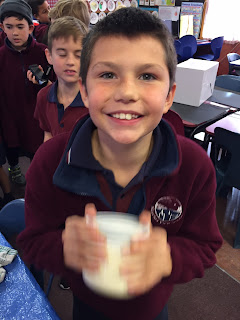HOME-MADE BUTTER
Today, some students made home-made butter with Mrs Kellie. Here are some photos & an explanation from Brayden.








Butter making
with Brayden, Rico, Indiana,
Nica, Yolanda, Caiden, Jeremiah, Lily-Grace and Daisy
Today we made butter. We made it
with pure cream, a couple of jars and salt (optional).
It was accompanied by
bread. We also used shop brought butter to compare the taste.
We poured the cream into two jars
till they about half full. We added salt to one jar. We took it
in turns
shaking each jar until we couldn’t hear the liquid moving around. When we
opened the jar
it had turned into whipped cream. We continued to shake it until
the whipped cream turned to a solid. We saw that the butter turned into a ball
on the side of the jar.
We opened the jars and Mrs Kellie
removed the butter milk by kneading it with a spoon. We did this so it didn’t
go rancid or make the bread so soggy. It changed colour after the butter milk
was removed, from a creamy white to yellow.
We cut up the bread into small
slices. We buttered the bread and compared the different tastes and textures.
We noticed that our salted butter had an acceptable amount of salt. But, shop
brought had 540mg of salt when it should only be 400mg. It was very salty!
The class-made butter was very
similar in texture to shop brought. Our class-made butters were the
favourite! It was such an easy process
we will do it again.
We learnt to hypothesise. We
learnt about force, states of matter like solid, liquid and gas. We learnt that
if it wasn’t for the milk fat it would remain a liquid. By whipping cream you
change the physical structure.
By Brayden


This really was a yummy experiment! I highly recommend making your own butter, simple, easy and delicious. Students developed their thinking by making a hypothesis and sharing their reasoning. At critical stages we analysed our progress and how our original thoughts had changed. They made connections to their 'Food for thought' inquiry. By building explanations and interpretations, reasoning with evidence, making connections, considering viewpoints and forming conclusions students built their understanding. Everyone had an opportunity to participate in the activity. Thank you Brayden for summarising our kitchen science.
ReplyDelete